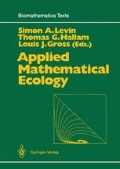Abstract
HIV, the human immunodeficiency acquired immunodeficiency syndrome virus, is the etiological agent for AIDS (acquired immuno deficiency syndrome). In 1982 Gallo suggested that the cause of AIDS was likely to be a new human retrovirus and, in 1983, researchers at the Pasteur Institute under the direction of Montagnier were able to isolate a new retrovirus from a New York AIDS victim (see Barre-Sinoussi et al., 1983). In 1984, Gallo and his colleagues isolated the same type of retrovirus and proved it to be the etiological agent of AIDS (for more details see Gallo, 1986, 1987; Wong-Staal and Gallo, 1985). This virus has been estimated to kill at least 30% of those infected. By April 1988, about 58,000 individuals have died of AIDS in the United States, and the Coolfont Report (1986) predicts that by 1991 the lower bound for the cumulative number of AIDS cases will be 290,000 individuals in the United States alone. One of the biggest problems associated with HIV is that most infected individuals appear to be asymptomatic and infectious for long periods of time, with an average infectious period of at least 8 years. Furthermore, there is growing evidence that the infectiousness of individuals varies with time since infection; the amount of free virus is relatively high just after infection (Francis et al., 1984; Salahuddin et al., 1984), remains low for several years, and climbs again within a year or so of the onset of AIDS (Lange et al., 1986).
Access this chapter
Tax calculation will be finalised at checkout
Purchases are for personal use only
Preview
Unable to display preview. Download preview PDF.
References
Anderson, R.M. (1988) The epidemiology of HIV infection: variable incubation plus infectious period and heterogeneity in sexual activity (ms.)
Anderson, R.M., May, R.M. (1987) Transmission dynamics of HIV infection. Nature 326, 137–142
Anderson, R.M., et al. (1988) A preliminary study of the transmission dynamics of the human immunodeficiency virus (HIV), the causative agent of AIDS. IMA J. Math. Med. Biol, (in press)
Barre-Sinoussi, F., et al. (1983) Isolation of a T-lymphotropic retrovirus from a patient at risk for acquired immune deficiency syndrome (AIDS). Science 220, 868–70
Blythe, S.P., Anderson, R.M. Distributed incubation and infectious periods in models of the transmission dynamics of the Human Immunodeficiency Virus (HIV). IMA J. Math. Med. Biol, (in press)
Castillo-Chavez, C., Cooke, K., Huang, W., Levin, S.A. (1988a) The role of infectious periods in the dynamics of acquired immunodeficiency syndrome (AIDS). In: C. Castillo-Chavez, S.A. Levin, and C. Shoemaker (eds.) Proceedings International Symposium in Mathematical Approaches to Ecological and Environmental Problem Solving, Ithaca, 1987. Lecture Notes in Biomathematics. Springer, Berlin Heidelberg New York (to appear)
Castillo-Chavez, C., Cooke, K., Huang, W., Levin, S.A. (1988b) The role of long infectious periods in the dynamics of HIV/AIDS. Part 1 (in preparation)
Castillo-Chavez, C., Cooke, K., Huang, W., Levin, S.A. (1988c) The role of infectious periods in the dynamics of in the dynamics of HIV/AIDS. Part 2 (in preparation)
Colgate, S.A., Hyman, J.M., Stanley, E.A. (1988) A risk base model explaining the cubic growth in AIDS cases (unpublished manuscript)
Coolfont Report (1986) A PHS plan for prevention and control of AIDS and the AIDS virus. Public Health Rep. 101, 341–48
Crow, J.F., Kimura, M. (1970) An introduction to population genetics theory. Burgess Publishing Company. Minneapolis, Minnesota
Dietz, K., Hadeler, K.P. (1988) Epidemiological models for sexually transmitted diseases. J. Math. Biology (in press)
Francis, D.P. et al. (1984) Infection of chimpanzees with lymphadenopathy-associated virus. Lancet, 1, 1276–77
Fredrickson, A.G. A mathematical theory of age structure in sexual populations: random mating and monogamous marriage models. 1971. Math. Biosci. 10, 117–143
Gallo, R.C. (1986) The first human retrovirus. Scientific American, Dec. 88–89
Gallo, R.C. (1987) The AIDS virus. Scientific American, Jan.: 47–56
Hyman, J.M., Stanley, E.A., (1988) A risk base model for the spread of the AIDS virus. Math. Biosci. (in press)
Kendall, D.G. (1949) Stochastic processes and population growth. J. Roy. Statist. Soc. Ser. Bll, 230–264
Keyfitz, N. (1972) The mathematics of sex and marriage. Proceedings of the Sixth Berkeley Symposium on Mathematical Statistics and Probability, vol. IV: Biology and Health, pp. 89–108
Lange, J.M.A., et al. (1986) “Persistent HIV antigenaemia and decline of HIV core antibodies associated with transition to AIDS.” Brit. Med. J. 293, 1459–62
May, R.M., Anderson, R.M., McLean, A.R. (1988a) Possible demographic consequences of HIV/AIDS: I, assuming HIV infection always leads to AIDS. Math. Biosci. (in press)
May, R.M., Anderson, R.M., McLean, A.R. (1988b) Possible demographic consequences of HIV/AIDS: II, assuming HIV infection does not necessarily lead to AIDS. In: Castillo-Chavez, C., Levin, S.A., Shoemaker, C. (eds.) Proceedings International Symposium in Mathematical Approaches to Ecological and Environmental Problem Solving, Berlin Heidelberg New York Ithaca, 1987. Lecture Notes in Biomathematics. Springer (to appear)
Pollard, J.H. (1973) Mathematical models for the growth of human populations, Chapter 7. The University Press, Cambridge
Suluhuddin, S.Z. et al. (1984) HTLV-III in symptom-free seronegative persons. Lancet, Dec. 22–29: 1418–20
Wong-Staal, F., Gallo, R.C. (1985) Human T-lymphotropic retroviruses. Nature 317, 395–403
Editor information
Editors and Affiliations
Rights and permissions
Copyright information
© 1989 Springer-Verlag Berlin Heidelberg
About this chapter
Cite this chapter
Castillo-Chavez, C. (1989). Review of Recent Models of HIV/AIDS Transmission. In: Levin, S.A., Hallam, T.G., Gross, L.J. (eds) Applied Mathematical Ecology. Biomathematics, vol 18. Springer, Berlin, Heidelberg. https://doi.org/10.1007/978-3-642-61317-3_11
Download citation
DOI: https://doi.org/10.1007/978-3-642-61317-3_11
Publisher Name: Springer, Berlin, Heidelberg
Print ISBN: 978-3-642-64789-5
Online ISBN: 978-3-642-61317-3
eBook Packages: Springer Book Archive

